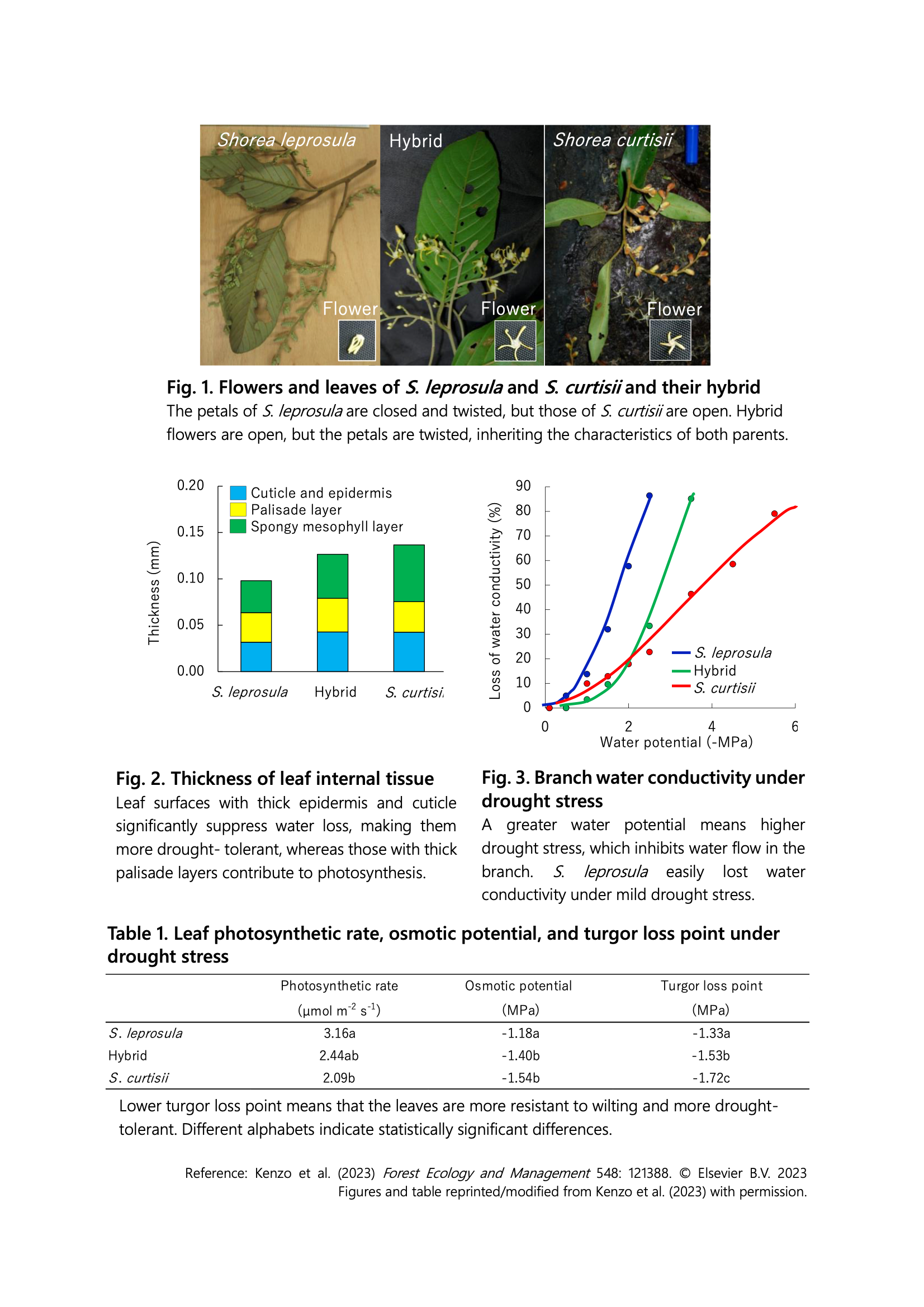Drought resilience of interspecific hybrids of the tropical forest trees Shorea leprosula and S. curtisii
Description
Climate change is predicted to increase drought frequency and intensity in the tropical rainforest regions of Southeast Asia, and there is concern that trees with low drought tolerance will die or grow poorly. The dipterocarp family, which dominates the forests of this region, is important as a timber resource. Among them, Shorea leprosula (Fig. 1) is suitable as plantation species due to its fast growth rate, but has the disadvantage of low drought tolerance. S. curtisii, on the other hand, grows slowly and takes longer to harvest, but can also be grown on dry ridges. An interspecific hybrid can combine the various characteristics of both parents and be used to create superior crop varieties. However, the characteristics of hybrids in dipterocarp trees are unknown. In this study, we investigated the leaf and branch characteristics associated with drought tolerance in interspecific hybrid seedlings between S. leprosula and S. curtisii to explore the potential for using hybrids to create varieties with high resilience to climate change.First, we compared leaf morphology and physiological characteristics. S. leprosula had the thinnest leaves but also had the highest proportion of palisade layer with a higher photosynthetic capacity. On the other hand, S. curtisii had a thick cuticle and epidermis that protected the leaves from desiccation, but the proportion of the palisade layer was low. Hybrids had leaves with medium characteristics or almost the same as in the parent species (Fig. 2). The photosynthetic capacity of S. leprosula was higher than that of S. curtisii, consistent with its faster growth rate. The capacity of the hybrid was intermediate between the parental species and is likely to grow faster than S. curtisii (Table 1). Second, we compared the pattern in which branches lose their water-permeating function under drought stress, and S. curtisii and hybrids were found to be more drought-tolerant than S. leprosula (Fig. 3). Finally, we artificially dried the soil and examined changes in leaf drought tolerance. The lower leaf osmotic potential in hybrids and S. curtisii indicated that they had a greater ability for osmotic regulation under drought conditions than S. leprosula. When drought tolerance was assessed by leaf wilting point (water potential at loss of turgor pressure), the leaves of S. leprosula wilted easily, but the hybrids and S. curtisii did not wilt easily and had high drought tolerance (Table 1).
Overall, it was clear that the leaves and branches of the hybrid are more drought-tolerant than S. leprosula. This suggests that hybrids can be used to create varieties with high drought resilience, helping tropical forestry adapt to climate change.
Figure, table
- Research project
- Program name
- KAKEN
- Research Project
-
科研費 20K06153
- Term of research
-
FY2021-2023
- Responsible researcher
-
Tanaka Kenzo ( Forestry Division )
ORCID ID0000-0002-4856-7204KAKEN Researcher No.: 30414486Ichie Tomoaki ( Kochi University )
ORCID ID0000-0002-1979-5806KAKEN Researcher No.: 80403872Norichika Yuki ( Kochi University )
Kamiya Koichi ( Ehime University )
ORCID ID0000-0003-3614-9029KAKEN Researcher No.: 80638792Inoue Yuta ( Forestry and Forest Products Research Institute )
ORCID ID0000-0002-2173-0331Ngo Kang Min ( Nanyang Technological University )
ORCID ID0000-0001-8273-6158Lum Shawn ( Nanyang Technological University )
ORCID ID0000-0003-2098-6308 - ほか
- Publication, etc.
-
Kenzo T, Ichie T, Norichika Y, Kamiya K, Inoue Y, Ngo KM, Lum SKY. (2023) Drought tolerance in dipterocarp species improved through interspecific hybridization in a tropical rainforest. Forest Ecology and Management 548: 121388https://doi.org/10.1016/j.foreco.2023.121388
- Japanese PDF
-
2023_A06_ja.pdf1.04 MB
- English PDF
-
2023_A06_en.pdf519.18 KB
* Affiliation at the time of implementation of the study.

